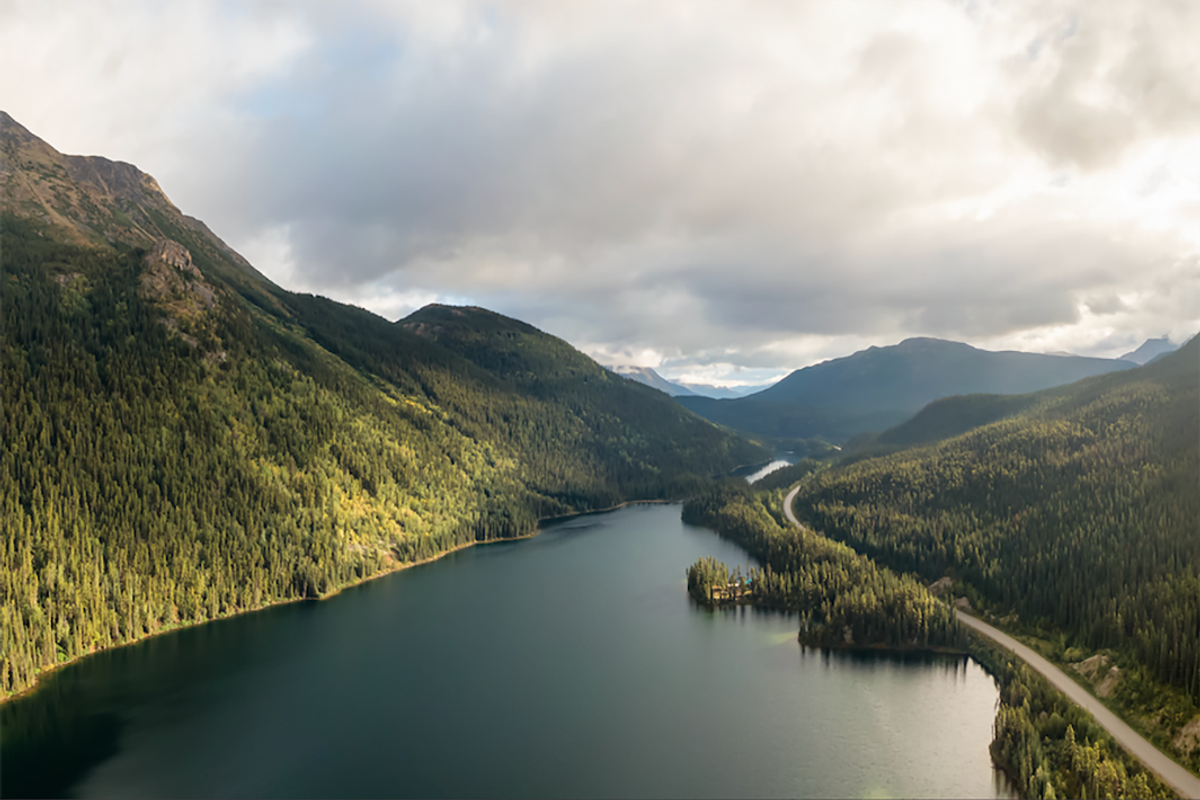
Significantly less than 1 percent of the prolific Golden Triangle has been mined to date, meaning this region is primed for new discoveries waiting to be unearthed.
British Columbia's Golden Triangle hosts some of the world's largest, richest metal deposits, with the first major gold discovery in the region dating back to the early 1900s.
Roughly the size of Portugal, the mining district stretches from the city of Stewart in the south to the Alaskan panhandle in the north. It is home to a range of precious and base metals, including gold, silver, copper, jade, zinc, obsidian and nickel.
Today, the Golden Triangle is a hotbed of exploration. Receding glaciers further heighten the region's prospective value, unveiling previously inaccessible deposits.
Experts believe that as mining and exploration companies continue to invest in the Golden Triangle and exploration technology grows progressively more advanced, there is the potential to discover deposits collectively worth hundreds of billions of dollars.
A prime region for precious metals
Situated within the Stikine Arch geological province, the Golden Triangle is exceptionally mineral-rich, with a prolonged, complex and varied metallogenetic history. It houses multiple porphyry and porphyry-related gold deposits and volcanogenic massive sulfides, resulting in some of the world's richest known deposits. This unique geology is largely a matter of location.
The Golden Triangle is situated along multiple deep faults, each of which served as a major conduit for mineral formation. Although the majority of this mineralization occurred between the late Triassic and early Jurassic periods, there is at least one major molybdenum deposit that formed during the Eocene era. The Larder-Cadillac zone in Lake Superior is the Golden Triangle's closest analogue in North America.
From prospecting to production
Home to several past-producing assets, the Golden Triangle's history is inextricably wrapped up in the history of Canada's mining sector — even before Canada was officially recognized as a country, the region was widely known amongst prospectors.
It has been the site of no less than three gold rushes, beginning with Alexander "Buck" Choquette's discovery of gold at the confluence of the Anuk and Stikine Rivers in 1861. This was followed almost immediately by the Cassiar Gold Rush in the 1870s and the Atlin Gold Rush, which began in 1898.
Gold rushes aside, the first major discovery in the region was the Premier Gold Mine, which began operations in 1918. Regarded as one of the greatest silver and gold mines in the world for its time, it remained the largest gold mine in North America until its closure in 1952. The former mine is now part of the 8,133 hectare Premier gold project, owned and operated by Ascot Resources (TSX:AOT).
The Snip mine, discovered by Cominco in 1964, was another major source of gold. First drilled in 1986 via a joint venture with Delaware Resources, the mine produced roughly one million ounces of gold from 1991 to 1999 at an average grade of 27.5 g/t. Skeena Resources (TSX:SKE) currently holds a 100 percent interest in the mine; exploration and development efforts are currently underway.
The third major operating mine in the Golden Triangle's history, Eskay Creek, produced 3.3 million ounces of gold and 160 million ounces of silver from 1994 to 2008. It is currently the site of a major revitalization project spearheaded by Skeena Resources.
Development in the region since 2008 has been relatively modest.
In 2008, Newcrest Mining (TSX:NCM) discovered the Brucejack gold and silver deposit, developing an underground mine that began operations in 2017. Seabridge Gold (TSX:SEA) in 2013 established the KSM project, which at the time was one of the world's largest undeveloped gold projects. Early stage construction began at the site in 2021. Finally, in 2015 Newcrest's Red Chris mine shipped its first load of copper concentrate.
A combination of then low gold prices and a relative lack of infrastructure were likely the causes for the relative lull in interest and development in the Golden Triangle. Economics didn't support the development of any assets in the Triangle, as logistics, labor and power costs were simply too high. Since then, however, gold prices have more than tripled in recent years, with new technology and infrastructure making exploration and development significantly more cost-effective.
Said infrastructure includes a C$700 million high-voltage transmission line, a paved highway between British Columbia and the Yukon Territory, the opening of ocean port facilities in the BC municipality of Stewart, and the completion of a 277 MW hydroelectric facility 70 kilometers to Stewart's northwest.
Blazing trails through unexplored potential
The Golden Triangle is now the site of another gold rush — one with the potential to be the largest yet.
For the past several years, it has been a veritable hotbed of exploration and discovery. The retreating glacier provides the opportunity to explore multiple regions that were previously inaccessible. Moreover, because so much of the region remains unexplored, new deposits could surface virtually anywhere.
The Golden Triangle hosts 26 exploration and development projects at various stages of completion as of 2021.
These include Goldplay Mining (TSXV:AUC) and its Scottie West gold project, Goliath Resources' (TSXV:GOT) prospective Golddigger property and the Cambria, Silver Crown, Independence, American Creek, Lower Bear and Bear Pass projects, owned by the now-merged Scottie Resources (TSXV:SCOT) and Aux Resources.
Other mining and exploration firms operating in the region include Origen Resources (CSE:ORGN) and Romios Gold Resources (CVE:RG), the latter of which recently made an compelling discovery at its Trek South project following the completion of a 2022 induced polarization survey.
The survey detected a strong IP chargeability high estimated to be over 800 meters long and up to 500 meters wide. The zone extends down below a depth of 600 meters, beneath both a large copper-tungsten skarn and the 1 kilometer wide porphyry-style alteration and mineralization zone the company discovered in 2021. The newly discovered anomaly also flanks both a recently exposed granodiorite pluton and a postulated buried pluton reflected by a circular aeromagnetic high.
The Trek South project sits within 1.3 kilometers of the partially cleared road route to Teck (TSX:TECK.A,TSX:TECK.B,NYSE:TECK) and Newmont’s (TSX:NGT,NYSE:NEM) enormous Galore Creek copper-gold porphyry deposits and just 13 kilometers from the proposed Galore Creek mill site.
"The combination of a large skarn target flanking an intrusion that is a potential host to porphyry type mineralization creates a drill target of the highest priority that will require a substantial financial commitment, and we are actively engaged in identifying a potential partner to bring their expertise and funding to support this important program," explained Stephen Burega, Romios Gold’s president and CEO.
Both the strength and the size of the main anomaly are very encouraging, Burega added. “While there is no guarantee of economic mineralization here, the size of the anomaly is comparable to some of the individual ore bodies at the Galore Creek deposit and it is flanked by three additional anomalies that remain to be evaluated in the field."
Takeaway
The Golden Triangle holds incredible promise. Though it's far from the only value-rich mining district in British Columbia, it has for decades been considered one of the top mining jurisdictions in the world. A significant new discovery in this region has the potential to completely change the fortunes of the company that claims it.
This fact alone should more than catch the interest of any prospective investors — and more than justifies paying very close attention to current developments, discoveries and plans for the future.
This INNSpired article was written as part of an advertising campaign for a company that is no longer a client of INN. This INNSpired article provides information which was sourced by INN, written according to INN's editorial standards, in order to help investors learn more about the company. The company’s campaign fees paid for INN to create and update this INNSpired article. INN does not provide investment advice and the information on this profile should not be considered a recommendation to buy or sell any security. INN does not endorse or recommend the business, products, services or securities of any company profiled. If your company would benefit from being associated with INN's trusted news and education for investors, please contact us.





